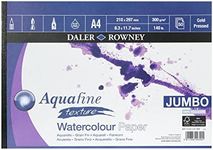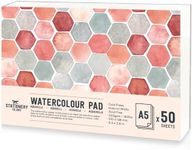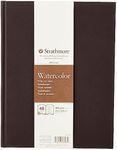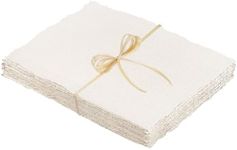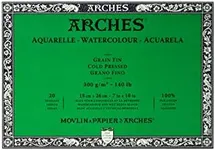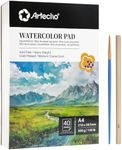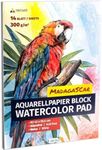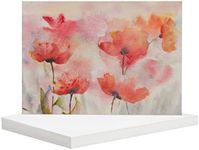Buying Guide for the Best Watercolor Paper
Choosing the right watercolor paper is crucial for achieving the best results in your artwork. Watercolor paper comes in various types, weights, and textures, each suited for different techniques and styles. Understanding these specifications will help you select the paper that best fits your needs and preferences.Paper WeightPaper weight refers to the thickness and sturdiness of the paper, usually measured in pounds (lb) or grams per square meter (gsm). Heavier paper (300 lb or 640 gsm) is more durable and can handle more water without warping, making it ideal for heavy washes and wet techniques. Medium weight paper (140 lb or 300 gsm) is versatile and suitable for most watercolor techniques. Lighter paper (90 lb or 190 gsm) is less expensive but may buckle under heavy washes. Choose heavier paper if you plan to use a lot of water or multiple layers, and lighter paper for practice or less intensive work.
Paper TextureWatercolor paper texture, also known as the paper's 'tooth,' affects how the paint interacts with the surface. There are three main textures: hot press, cold press, and rough. Hot press paper is smooth and allows for fine details and sharp lines, making it ideal for detailed work and illustrations. Cold press paper has a slightly textured surface that holds water and pigment well, suitable for most watercolor techniques and styles. Rough paper has a pronounced texture that creates interesting effects and is great for expressive, loose painting. Choose the texture based on your painting style and the level of detail you want to achieve.
Paper MaterialWatercolor paper can be made from different materials, primarily cotton or wood pulp. Cotton paper is considered superior due to its durability, absorbency, and ability to withstand heavy washes without warping. It is often used by professional artists for high-quality work. Wood pulp paper is more affordable and suitable for beginners or practice pieces. If you are looking for the best quality and longevity, opt for 100% cotton paper. For casual use or practice, wood pulp paper is a good choice.
Paper SizeWatercolor paper comes in various sizes, from small pads to large sheets. The size you choose depends on the scale of your work and your workspace. Smaller sizes (such as 9x12 inches) are portable and convenient for sketching and small projects. Medium sizes (such as 12x16 inches) offer a balance between portability and space for more detailed work. Larger sizes (such as 18x24 inches) provide ample space for expansive compositions and detailed paintings. Consider the size based on your project needs and how much space you have to work with.
Paper FormatWatercolor paper is available in different formats, including pads, blocks, sheets, and rolls. Pads are convenient for on-the-go painting and practice. Blocks are glued on all sides, preventing warping and making them ideal for wet techniques. Sheets offer flexibility in size and are great for larger projects. Rolls provide the most flexibility in size and are suitable for very large works or custom sizes. Choose the format based on your painting habits and the type of projects you plan to undertake.
